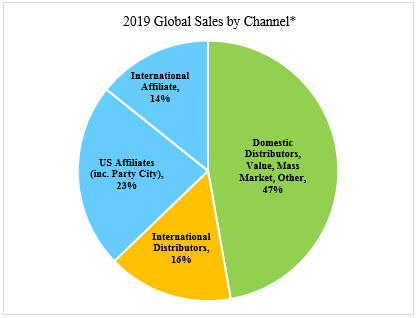MANAGEMENT’S DISCUSSION AND ANALYSIS OF FINANCIAL CONDITION AND RESULTS OF OPERATIONS
OF ANAGRAM
The following management’s discussion and analysis should be read in conjunction with “Summary Consolidated Financial and Other Data—Anagram.” The following management’s discussion and analysis contains forward-looking statements that reflect Anagram’s future plans, estimates, beliefs and expected performance. The forward-looking statements are dependent upon events, risks and uncertainties that may be outside Anagram’s control. Anagram’s actual results may differ materially from those anticipated in these forward-looking statements as a result of various factors, including those set forth under “Risk Factors,” and in other parts of this offering memorandum. As a result of these risks, uncertainties and assumptions, the forward-looking events discussed may not occur.
Except as otherwise indicated or unless the context otherwise requires, in this section “Management’s Discussion and Analysis of Financial Condition and Results of Operations of Anagram,” the terms “we,” “us” and “our” refer to Anagram.
Basis of Presentation
Anagram is the world innovator and leader in foil balloons and inflated décor. Because the summary historical combined financial data that we have included in this offering memorandum is limited in scope and relates to the performance of Anagram prior to completion of the Refinancing Transactions, this management’s discussion and analysis is similarly limited. See the form of the Anagram Indentures that are attached as Exhibits A and B to this offering memorandum and specifically the covenant entitled “Reports” for a description of Anagram’s reporting requirements following the issuance of the Anagram Notes.
Factors Affecting Anagram’s Financial Condition and Results of Operations
In assessing the performance of Anagram, management considers a variety of performance and financial measures, including: revenues, cost of sales, gross profit, and Sales, General & Administrative expenses. Anagram management also reviews other metrics such aspre-tax income (loss) and Adjusted EBITDA.
Revenues
Revenue is recognized when product is shipped and ownership is transferred to the customer. For most wholesale sales, control transfers upon the shipment of the product as: (i) legal title transfers on such date and (ii) we have a present right to payment at such time. Wholesale sales returns are not significant as we generally only accept the return of goods that were shipped to the customer in error or that were damaged when received by the customer. Additionally, due to our extensive history operating as a leading balloon product wholesaler, we have sufficient history with which to estimate future sales returns and we use the expected value method to estimate such activity.
Cost of Sales
Cost of sales reflects the production costs (i.e., raw materials, labor and overhead) of our manufacturing facilities and processes, product development, royalties associated with sale of licensed goods, inbound freight to our manufacturing and distribution facilities and distribution costs related to our distribution center and outbound freight to get goods to our wholesale customers.
Anagram’s cost of sales increases in higher volume periods as the direct costs of manufactured and purchased goods and freight are generally tied to net sales. However, other costs are largely fixed, such as our facility costs, or vary based on other factors and do not necessarily increase as sales volume increases. Changes in the mix of our products may also impact our overall cost of sales. The direct costs of manufactured and purchased goods are influenced by raw material costs (inks, coated film, petroleum-based resins), domestic and international labor costs in the countries where our goods are manufactured or purchased and logistics costs associated with transporting our goods.
Cost of sales related to sales from our wholesale operations to our retail operations are eliminated in our consolidated financial statements.
8
